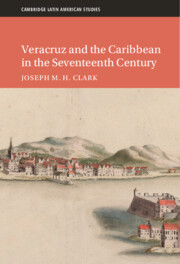Book contents
- Veracruz and the Caribbean in the Seventeenth Century
- CAMBRIDGE LATIN AMERICAN STUDIES
- Veracruz and the Caribbean in the Seventeenth Century
- Copyright page
- Dedication
- Contents
- Figures
- Maps
- Tables
- Acknowledgments
- Note on the Text
- Abbreviations
- Maps
- Introduction
- Part I Building the Mexican-Caribbean World
- 1 Veracruz Before the Caribbean
- 2 Environment, Health, and Race, 1599–1697
- 3 Imperial Designs and Regional Systems
- 4 The Large and Small-Scale Introduction of Africans to Veracruz
- Part II The Caribbean in Veracruz
- Appendices
- Bibliography
- Index
- Cambridge Latin American Studies
1 - Veracruz Before the Caribbean
from Part I - Building the Mexican-Caribbean World
Published online by Cambridge University Press: 19 January 2023
- Veracruz and the Caribbean in the Seventeenth Century
- CAMBRIDGE LATIN AMERICAN STUDIES
- Veracruz and the Caribbean in the Seventeenth Century
- Copyright page
- Dedication
- Contents
- Figures
- Maps
- Tables
- Acknowledgments
- Note on the Text
- Abbreviations
- Maps
- Introduction
- Part I Building the Mexican-Caribbean World
- 1 Veracruz Before the Caribbean
- 2 Environment, Health, and Race, 1599–1697
- 3 Imperial Designs and Regional Systems
- 4 The Large and Small-Scale Introduction of Africans to Veracruz
- Part II The Caribbean in Veracruz
- Appendices
- Bibliography
- Index
- Cambridge Latin American Studies
Summary
Chapter 1 takes the long view of regional development in Mexico’s Gulf Coast lowlands, from prehistory through Veracruz’s foundation in 1519 and its refounding as Nueva Veracruz in 1599. It examines geography, environment, and how human societies mediated coastal spaces before the seventeenth century. It culminates with Veracruz’s 1599 relocation, which followed an extended battle between powerful merchants in Mexico City, Seville, and Puebla and Veracruz’s own cabildo. While metropolitan merchants and administrators wanted to locate the city closer to port facilities at San Juan de Ulúa, local officials resisted the move, arguing the coastal climate was “unfit for the sustenance of life” and proposing to relocate it further into the mainland interior. By the end of the sixteenth century, metropolitan forces had won out, moving Veracruz closer to the port and securing the primacy of coastal climates and maritime commerce and migration in its social and cultural development in the seventeenth century.
- Type
- Chapter
- Information
- Veracruz and the Caribbean in the Seventeenth Century , pp. 23 - 48Publisher: Cambridge University PressPrint publication year: 2023

